B-17 ‘The Movie’ Memphis Belle: Making missions come alive
Veteran Casey Bukowski takes careful aim from the nose of “The Movie” Memphis Belle during a flight at the National Warplane Museum Airshow in Geneseo, New York. (Anthony C. Hayes)
GENESEO, NEW YORK — With the passage of time, many facets of World War II are quickly fading. But for those willing to travel to the National Warplane Museum in Geneseo, New York, this summer, one important aspect remains well within reach: the experience of flying in a classic warbird.
We were thrilled to be invited up to Geneseo for this year’s National Warplane Museum Airshow. There we took rides on not one but two historic aircraft – a B-17 and C-47. Having recently experienced a hands-on flight in a P-40 Warhawk at the Mid-Atlantic Air Museum in Reading, PA, we knew we were in for a special treat.
First up was our ride on “The Movie” Memphis Belle. (We’ll tell you about the C-47 “Whiskey 7″ in a later story.)
“The Movie” Memphis Belle is not to be confused with the original Memphis Belle, which has now been completely restored and is on display at the Air Force Museum in Dayton, Ohio.
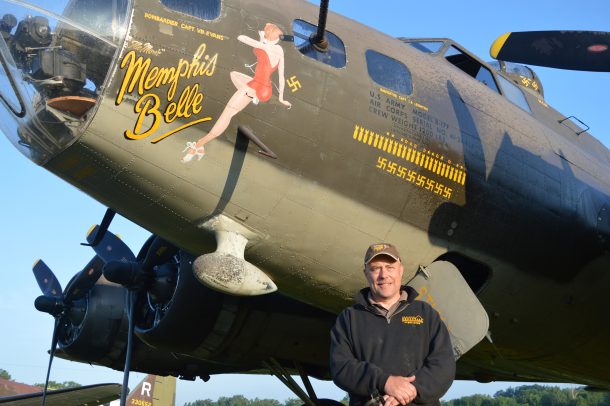
“The Movie” Memphis Belle is a ‘G’ model Flying Fortress converted over to an ‘F’ model for use in the 1990 movie Memphis Belle,” explained pilot Peter Treichler. “I’ve been flying it for a little more than a year, but it’s not like flying a modern airplane.
“In a modern plane, you have pressurization and digital flight control. This airplane is all mechanical. It’s old school and takes a lot of effort. Both pilots have to work together to make sure all the systems are working well – particularly the engines. For example, when you’re coming in for an approach, whoever is flying the airplane will be steering it while the other guy is working the engines for him and adjusting the power settings.”
What kind of people are attracted to a flight in the B-17?
“The passengers who come to us for rides are all different kinds of people,” said Treichler. “People who want to experience what it was like to be in one of these airplanes. Veterans who have flown in the airplane operationally. A lot of it is just to get a taste of what it was like when guys were flying these airplanes back in the 1940s.
“We usually go up for about a thirty-minute ride. Everyone gets a safety briefing before boarding. People seated in the front get a look at what it takes to start the engines. They’ll get a gook look at the smoke, the vibration and sound. They’re Wright Cyclone engines – 1820 cubic inches and 1200 horsepower a piece.
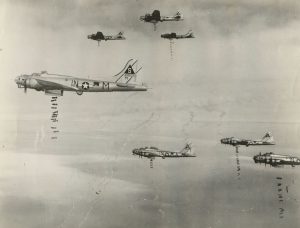
“The B-17 was a heavy bomber, so its purpose was to deliver ordnance on a target. Of course, to get to the target you had to fly through flak and fighters. To defend yourself, you had several .50 caliber machine guns placed throughout the plane – some with dedicated operators, such as the waist and tail gunners. Other guys had multiple jobs, like the flight engineer. He also ran the top turret gun. The navigator and bombardier had .50s as well to operate. Once they were in the combat area, everyone was very busy.”
Your Objective: Upstate New York
At the appointed hour, we were rounded up by flight engineer Ken Strohm and given the safety briefing, along with our seat assignments. I drew a plum spot in the nose of the B-17 – the navigator’s position – right behind the bombardier.
Ken also introduced me at that point to “Casey” Bukowski – a 95-year-young veteran of fifteen missions over Germany. Casey would later tell me that the 15th mission was the one which effectively retired him. His plane was shot down, he lost an eye, and he was a guest of the Luftwaffe for the final fourteen months of the war.
The briefing completed, our complement of ten passengers began to board. Squeezing through the empty steel racks in the bomb bay, then crawling under the cockpit, I made my way to the front of the plane.
Though oven-like as we sat on the ground, the nose of the B-17 offers the most expansive vistas on the ride. That makes perfect sense, since it was the navigator – and finally the bombardier – who would guide the plane to its target.
Joining me in the very hot seat was Spencerport, NY native, Rick Pier. Rick said he had been looking forward to the flight for several months.
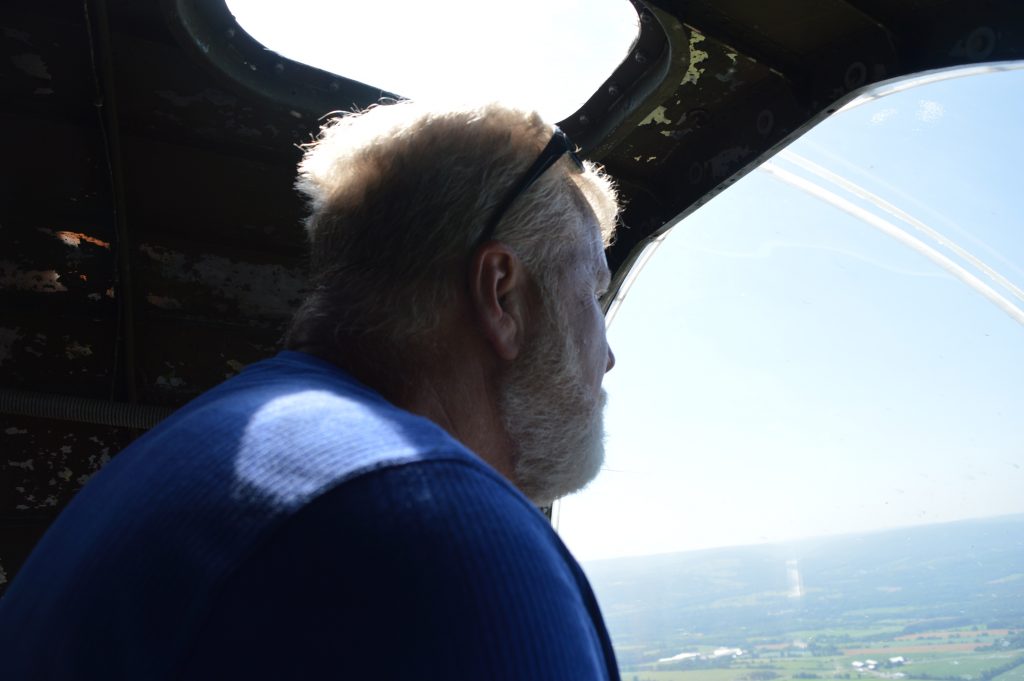
(Anthony C. Hayes)
“My wife found this for my 60th birthday. I’ve been waiting to do this since then so I’m really psyched.”
Less thrilling was the task of strapping ourselves in.
Reaching for extra slack in our lap belts, Rick and I both chuckled about the need to lose a few pounds. I probably did during the course of that flight, since I was wearing my wool War Correspondent’s uniform.
Our pre-flight conversation was cut short, first by a final check visit from flight engineer Mike Piampiano, then by the rising roar of the Wright Cyclone engines, which were started one at a time. Through a web of steel grating above and behind me, I could spy pilot Peter Treichler working the controls. Hand gestures from spotters on the ground signaled that the way was clear, and it was time to roll.
Ironically, as we made our way to the runway, we were following the P-40 Warhawk America Dream. It was amazing to watch that grimacing fighter rev its Allison engine, then sprint down the runway and leap into the air.
We were next, and save for the shaking of the plane as it dashed across the turf, the take-off seemed effortless, as the huge Cyclone engines lifted the old warbird off the ground. Treichler said we would be cruising at about 120mph. That was tame compared to my 290mph flight in the P-40, but then we weren’t going to be doing any rolls in the B-17.
A Flight Through Time
Once we had gained an altitude of about 2500 feet, we were cleared to unfasten our lap belts and move about the plane. The bow compartment had cooled considerably by then, thanks in part to the removal of a cereal box-sized hatch just above my seat.
Others took full advantage of the views from the wide-open windows at the radio operator and waist gunners’ positions. Of course, Rick and I weren’t going anywhere. We had the best seats in the house. But several of our compatriots made their way forward for a quick peek out the gleaming plexiglass nose.
One of those who made his way forward was Casey Bukowski.
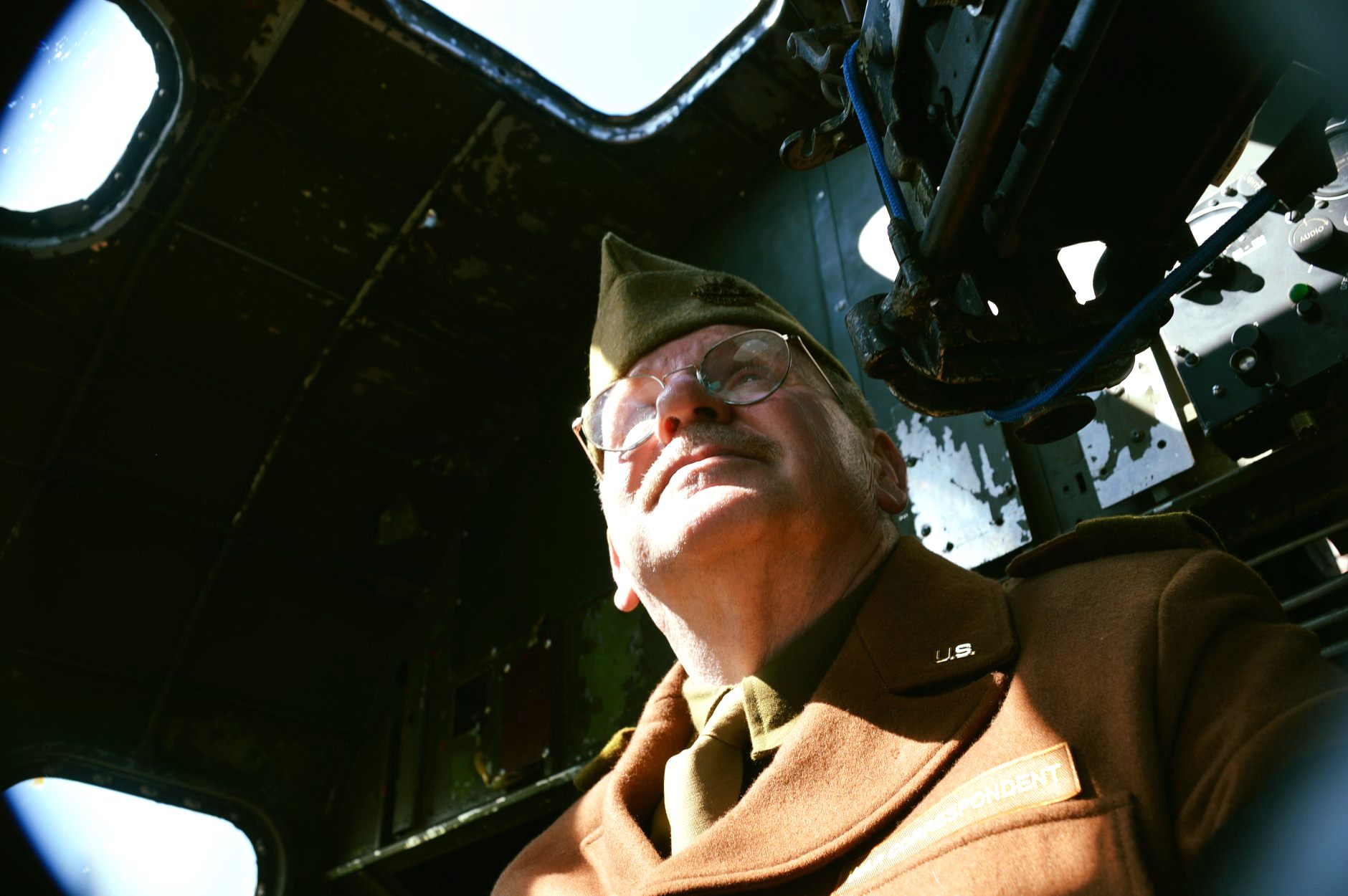
Gladly giving up my navigators nest, Casey made himself at home.
“I used to fire one of these,” he reported with a smile, as he grabbed the handles of the starboard machine gun. Checking needle positions on the instrument panels, then peering purposely through the nose, he sighed, “This really takes me back.”
The terrain below us was unfamiliar but incredibly gorgeous just the same. Rick shouted that we were flying over Conesus Lake.
I wondered, as we soared above the spectacular landscape, how many servicemen had looked down at the various theatres of World War II, the way I was looking at western New York?
Thirty minutes may seem rather short, but time stood still for us on that flight. Frankly, all were surprised when it was time to return to our seats and fasten back in for the landing.
I turned to Casey and asked if it would be all right to interview him once the plane had landed. Casey gave me a thumbs up and quick salute, then – as Rick and I watched in utter amazement – disappeared effortlessly through the small crawlspace.
As the “Belle” made a sweeping turn and began her approach, we took the time to savor the final moments of our flight.
“Wow! That was awesome!” exclaimed Rick, once the ‘Belle’ finally came to a rest. “A hell of a ride of a lifetime!”
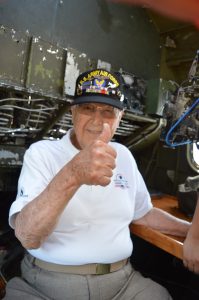
(Anthony C. Hayes)
I asked Rick if he had an interest in going up on the P-40?
“Perhaps that’ll be a future birthday present,” he said, with the broadest of grins.
Pausing beneath the wings, we encountered sixth-grader Tyler Conner. Tyler said he had snapped “about a thousand pictures” of the airfield and his ride on “The Movie” Memphis Belle.
“I had a great time with my 30-minute flight around Geneseo – seeing a lot of landmarks from the air. It was phenomenal! It wasn’t too noisy, either. For a 12-year-old, it was a once-in-a-life time thing!
“I’ve loved the Memphis Belle ever since I saw the movie. I actually have an autographed copy here in my bag. I thank the National Warplane Museum for having it here and letting me ride.”
Boylstonian Tom LaRoche (who took a later flight) was understandably giddy, when he got off the plane.
Boyishly beaming , Tom half-kiddingly said, “This is the most exciting thing I’ve done, since my ride in the Batmobile!”
The following day, Tom sent along an email, which said in part:
Mr. Hayes,
You did a short interview with me after I flew on the Memphis Belle. When we met, I was still on an Adrenalin rush.
After having thought more about the experience, I came to appreciate the young guys who flew in those planes during the war.
During my flight, I did not have flak exploding around me, nor did I have anybody firing machine guns at me from another plane. Nor did I have to return fire and, more importantly, I did not have to crawl through a damaged plane looking for the way out.
And, while I’m bigger than most of those airmen, I didn’t have a parachute hanging off me, nor was I in a bulky flight suit and in thin, very cold air.
Just trying to get out of that plane parked on the ground took some planning, contortions, and effort. Glad I didn’t have to do it while the plane was spinning out of control in the air.

This was not our first time on “The Movie” Memphis Belle, but it was far and away our most exciting experience. For that we have to thank the management of the National Warplane Museum, Warbird Adventures, the enthusiasm of our fellow passengers, and of course the dedicated volunteers and crew of the “The Movie” Memphis Belle.
While “The Movie” Memphis Belle is permanently based in Geneseo, she snowbirds with Warbird Adventures in Kissimmee, FL. The twin ports provide easy access to airshows throughout the season, as well as opportunities for enthusiasts to put their butts in the seats AND some much needed skin in the game.
How easy is it to get involved in the care of vintage aircraft or become a crew member on “The Movie” Memphis Belle?
“The museum is always looking for volunteers,” said Treichler, “and becoming a pilot is certainly accessible. There is actually a shortage of pilots for these classic warbirds. To get there, it’s just building the same kind of blocks pilots did during the war. You start on a smaller trainer like a Stearman, moving on to a more advanced plane like a Texan, and slowly working your way up to a four-engine design.
“There are other positions, too, like ground maintenance, support, or being a flight engineer. If you call the museum, I’m sure they’d be happy to point you in the right direction.”
For now, the direction of “The Movie” Memphis Belle is education, entertainment and inspiration. It’s a mission Casey Bukowski wholeheartedly endorses.
“I just can’t explain what it means to me whenever I see that airplane,” said Casey. “For me, it’s like I’m 18 years old again.”
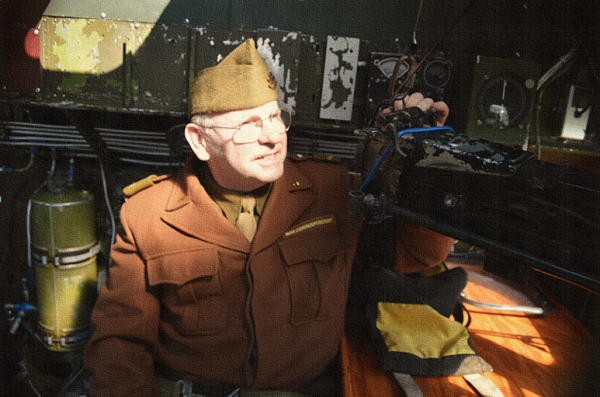

Anthony C. Hayes is an actor, author, raconteur, rapscallion and bon vivant. A one-time newsboy for the Evening Sun and professional presence at the Washington Herald, Tony’s poetry, photography, humor, and prose have also been featured in Smile, Hon, You’re in Baltimore!, Destination Maryland, Magic Octopus Magazine, Los Angeles Post-Examiner, Voice of Baltimore, SmartCEO, Alvarez Fiction, and Tales of Blood and Roses. If you notice that his work has been purloined, please let him know. As the Good Book says, “Thou shalt not steal.”

